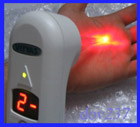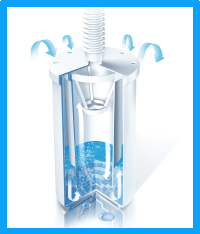Aromatherapy
What is Aromatherapy?
Aromatherapy means "treatment using scents". It is a holistic treatment of caring for the body with pleasant smelling botanical oils such as rose, lemon, lavender and peppermint. The essential oils are added to the bath or massaged into the skin, inhaled directly or diffused to scent an entire room. Aromatherapy is used for the relief of pain, care for the skin, alleviate tension and fatigue and invigorate the entire body. Essential oils can affect the mood, alleviate fatigue, reduce anxiety and promote relaxation. When inhaled, they work on the brain and nervous system through stimulation of the olfactory nerves.
The essential oils are aromatic essences extracted from plants, flowers, trees, fruits, bark, grasses and seeds with distinctive therapeutic, psychological, and physiological properties, which improve and prevent illness. There are about 150 essential oils. Most of these oils have antiseptic properties; some are antiviral, anti-inflammatory, pain-relieving, antidepressant and expectorant. Other properties of the essential oils which are taken advantage of in aromatherapy are their stimulation, relaxation, digestion improvement, and diuretic properties. To get the maximum benefit from essential oils, it should be made from natural, pure raw materials. Synthetically made oils do not work.
Aromatherapy is one of the fastest growing fields in alternative medicine. It is widely used at home, clinics and hospitals for a variety of applications such as pain relief for women in labor pain, relieving pain caused by the side effects of the chemotherapy undergone by the cancer patients, and rehabilitation of cardiac patients.
Aromatherapy is already slowly getting into the mainstream. In Japan, engineers are incorporating aroma systems into new buildings. In one such application, the scent of lavender and rosemary is pumped into the customer area to calm down the waiting customers, while the perfumes from lemon and eucalyptus are used in the bank teller counters to keep the staff alert.
History of Aromatherapy
Aromatherapy had been around for 6000 years or more. The Greeks, Romans, and ancient Egyptians all used aromatherapy oils. The Egyptian physician Imhotep recommended fragrant oils for bathing, massage, and for embalming their dead nearly 6000 years ago. Imhotep is the Egyptian god of medicine and healing. Hippocrates, the father of modern medicine, used aromatherapy baths and scented massage. He used aromatic fumigations to rid Athens of the plague.
The modern era of aromatherapy is dawned in 1930 when the French chemist Rene Maurice Gattefosse coined the term aromatherapy for the therapeutic use of essential oils. He was fascinated by the benefits of lavender oil in healing his burned hand without leaving any scars. He started investigating the effect of other essential oils for healing and for their psychotherapeutic benefits.
During world war II, the French army surgeon Dr. Jean Valnet used essential oils as antiseptics. Later, Madame Marguerite Maury elevated aromatherapy as a holistic therapy. She started prescribing essential oils as remedy for her patients. She is also credited with the modern use of essential oils in massage.
Aromatherapy works the best when it works on the mind and body simultaneously.
How Does Aromatherapy Work?
H E A L T H
L i v e a g r e a t l i f e
Name of the chemical component
|
Properties of the chemical component
|
Essential oils that contain the chemical
|
Aldehydes
|
anti-inflammatory,calming, sedative and anti-viral.
|
Characteristic lemon-like smell, such as lemon grass, lemon balm, citronella, eucalyptus
|
Alcohols
|
bactericidal (kills bacteria), stimulant, energizing, vitalizing, antiviral, diuretic. Our pancreas produce 32 kinds of alcohol for use in human metabolism.
|
Rose, petitgrain, rosewood, peppermint, myrtle, tea tree, sandalwood, patchouli, and ginger
|
Phenols
|
strongly bactericidal, tonic, stimulates immune system, invigorating, warming. Can produce slight liver toxicity if taken high doses for extended periods of time. Used in lip balms and cough drops.
|
Clove, cinnamon, thyme, oregano, savory, cumin.
|
Cetone (Ketones)
|
wound healing, mucolytic (eases the secretion of mucous), stimulates new cell growth. used as a nail polish.
|
Camphor, rosemary, sage, eucalyptus globulus and hyssop
|
Terpenes
|
Very stimulating, potential skin irritants, anti-viral properties.
|
Lemon, orange, bergamot, black pepper, pine oils, nut meg and angelica.
|
Sesquiterpenes
|
anti-phlogistic (moves fluids), anti-inflammatory, sedative, anti-viral, anti-carcinogenic, bacteriostatic and immune stimulant
|
Blue chamomiles, immortelle, tansy, yarrow and tagetes.
|
Esters
|
anti-fungal, sedative, calming, spasmolytic, fungicidal, anti-inflammatory.
|
Roman chamomile, lavender, clary sage, petitgrain, bergamot.
|
Lactones (part of ester group)
|
anti-inflammatory, mucolitic
|
arnica, elecampane
|
Ethers
|
harmonizing to the nervous system. antiseptic, stimulant, expectorant (increases secretions), spasmolytic, and diuretic.
|
Cinnamon, clove, anise, basil, tarragon, parsley, and sassafras.
|
Each essential oil contains as much as 100 chemical components, which together exert a strong effect on the whole person. Depending on which component is predominating in an oil, the oils act differently. For example, some oils are relaxing, some soothes you down, some relieves your pain, etc. Then there are oils such as lemon and lavender, which adapt to what your body needs, and adapt to that situation. (These are called "adaptogenic"). The mechanism in which these essential oils act on us is not very well understood. What is understood is that they affect our mind and emotions. They leave no harmful residues. They enter into the body either by absorption or inhalation.
A fragrance company in Japan conducted studies to determine the effects of smell on people. They have pumped different fragrances in an area where a number of keyboard entry operators were stationed and monitored the number of mistakes made as a function of the smell in the air. The results were as follows: When exposed to lavender oil fragrance (a relaxant), the keyboard typing errors dropped 20 percent.
When exposed to jasmine (an uplifting fragrance), the errors dropped 33 percent
When exposed to lemon fragrance (a sharp, refreshing stimulant), the mistakes fell by a whopping 54 percent!
Which Problems can Aromatherapy Help? Results of Clinical Studies
Aromatherapy is particularly effective for stress, anxiety, and psychosomatic induced problems, muscular and rheumatic pains, digestive disorders and women's problems, such as PMS, menopausal complaints and postnatal depression. Here is a summary of the results from clinical studies:
Aromatherapy for Behavior
Considerable evidence exists that fragrant compounds and aromatherapy have a profound effect on our mind and behavior. Animal studies have found that hyperexcited mice (as a result of consuming a large quantity of caffeine) was calmed by the aroma of lavender, sandalwood, and other oils sprayed into their cages. The same mice were found to become very irritable when exposed to the aroma of orange terpines, thymol, and some other substances. These oils were all detected in their bloodstream after about an hour.
Aromatherapy for Sleep
In a study reported in the British Medical Journal Lancet, elderly patients slept "like babies" when a lavender aroma was wafted into their bedrooms at night. These patients had complained of difficulty falling asleep and had to take sleeping pills to get sleep prior to the aromatherapy.
Aromatherapy for Postpartum discomfort
In a double blind study, 635 women applied lavender oil to their perineal area (part of the body between the vagina and the rectum) after child birth. The women reported a distinct improvement between the third and fifth day. (The discomfort is the worst during this time for patients in the control group.)
Aromatherapy for Colds
It has been well established that chicken soup is good for cold (both historically and scientifically). Studies were conducted to find out whether the effect was due to the action of the hot steam on the lining of the nostrils or whether the aroma of the chicken soup has anything to do with it. The results indicated that chicken soup was more effective than the steam indicating the effectiveness of the aroma.
Aromatherapy for Stress
In a study conducted at the Memorial Sloan-Kettering Hospital in New York, patients undergoing magnetic resonance imaging (MRI) reported 63 percent less claustrophobic after getting exposed to the aroma of vanilla. There was no change in their heart rate. Obviously, the aroma reduced their anxiety probably by the pleasant memories evoked by the vanilla aroma or by some other physiological response.
In another study, 122 patients who were in an intensive care unit, reported feeling much better when aromatherapy was administered with the oil of lavender (compared to when they were simply given a massage or allowed to rest.) No changes in the patients who were given aromatherapy was observed in the blood pressure, respiration, or heart rate. As we mentioned before, Japanese have reported less mistakes by keypunch operators when exposed to fragrance.
Aromatherapy and Male Sexual Response
Circulation to the male sexual organ was found to have improved substantially by treatment with licorice or lavender with pumpkin pie. Doughnut with black licorice was also very effective. Men who are considered the most sexually active responded well to lavender, cola, and oriental spice; older males preferred the fragrance of vanilla. These studies prove that aromatherapy is an effective therapy for the treatment of male impotence from the blood vessel disease or from psychogenic factors.
Safety Issues of Essential Oils
If used as recommended, and under the care of a qualified practitioner, aromatherapy is very safe. Please remember that essential oils are very concentrated. Do not use too much. (Too much is not better in case of essential oils.) Also, please be wary of any allergies people have to essential oils. (Try on a small spot to see whether there is any allergic reactions before exposing the whole body). Caution is particularly recommended for patients who are pregnant, have allergy, high blood pressure or epilepsy. Be careful with young children or babies. If you accidentally spill the essential oils on your skin or eye, wash it off immediately with whole milk. Milk with some fat in it is best for reducing irritation and removing the oil actually in the eye. You may also use olive oil or other vegetable oil to resolve any issues if experiencing a burning sensation which would be possible with oils like peppermint. Watch out for inflamed skin if you use essential oils. If you consume the oil by accident, drink lot of milk, eat soft bread, and go to the nearest poison control center for appropriate action.
Oral consumption of aromatic oils are strongly discouraged unless you are under the care and supervision of an experienced practitioner. Many of these essential oils are very toxic. You should not apply the undiluted essential oil on your body as these are very concentrated and you may experience discomfort. The exception to this is lavender oil which can be applied safely in the undiluted form for burns and insect bites.
It is a very good idea to keep your eyes closed while inhaling the aromatic oil. This helps build up your imagery which enhances the effect of the essential oil. It also prevents the "fumes" from irritating the eyes at close range. Don't apply any oils close to your eyes.
Certain oils such as mint oil causes insomnia. Do not use it at night (if you want go to sleep.)
Essential Oils for Relaxation
The following oils and spices are useful for relaxation.
Basil
Benzoin Tincture
Bergamot
Black Pepper
Cajeput
Camomile, Roman
Camphor
Cardamom Seed
Cedarwood
Cinnamon
Clary Sage
Clove
Coriander
Cypress
Eucalyptus
Fennel
Frankincense
Geranium
Ginger
Grapefruit
Hyssop
Jasmine
Juniper
Lavender
Lemon
Lemongrass
Marjoram
Melissa
Myrrh
Neroli
Orange
Patchouli
Palma Rosa
Peppermint
Pine
Rose Otto
Rosemary
Rosewood
Sage
Sandalwood
Tea Tree
Thyme
Ylang Ylang


